Click on images to enlarge
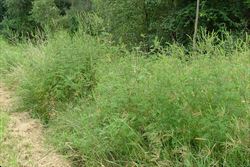
infestation (Photo: Sheldon Navie)
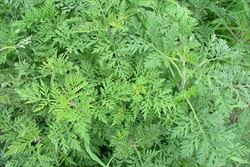
habit prior to flowering (Photo: Sheldon Navie)
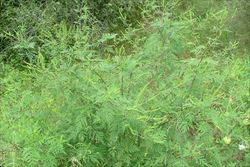
habit in flower (Photo: Sheldon Navie)
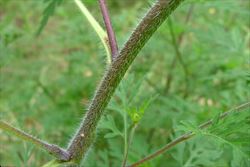
hairy rounded stem (Photo: Sheldon Navie)
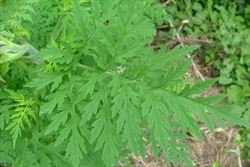
highly-divided and fern-like lower leaf (Photo: Sheldon Navie)
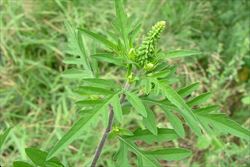
smaller, alternately arranged, and less-divided upper leaves (Photo: Sheldon Navie)
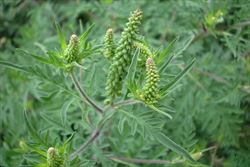
young flower clusters (Photo: Sheldon Navie)
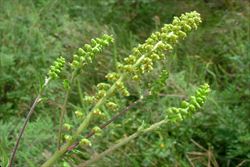
male flower-heads in elongated clusters (Photo: Sheldon Navie)
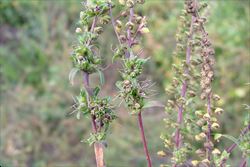
female flower-heads and fruit, left, and old male flower-heads, right (Photo: Sheldon Navie)
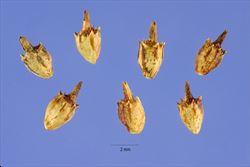
close-up of seeds (Photo: Steve Hurst at USDA PLANTS Database)
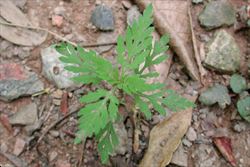
seedling (Photo: Sheldon Navie)
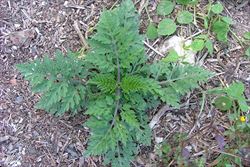
young plant forming a rosette of oppositely arranged leaves (Photo: Sheldon Navie)

adult Zygogramma bicolorata beetles on annual ragweed leaves (Photo: Sheldon Navie)

larvae of the stem-galling moth Epiblema strenuana in an annual ragweed stem (Photo: Sheldon Navie)
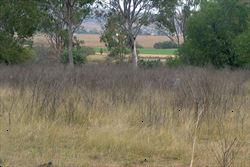
large infestation of old plants in a native pasture (Photo: Sheldon Navie)
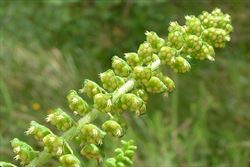
close-up of male flower-heads from below (Photo: Sheldon Navie)
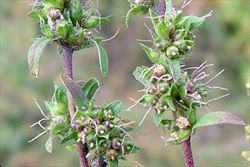
close-up of immature and mature fruit (Photo: Sheldon Navie)
Scientific Name
Ambrosia artemisiifolia L.
Synonyms
Ambrosia diversifolia (Piper) Rydb.Ambrosia elatior L.Ambrosia media Rydb.Ambrosia monophylla (Walt.) Rydb.
Family
Asteraceae (Queensland, New South Wales, the ACT, Victoria, Tasmania, Western Australia and the Northern Territory)Compositae (South Australia)
Common Names
ambrosia, American wormwood, annual bur-sage, annual ragweed, asthma plant, bastard wormwood, bitterweed, black weed, blackweed, carrot weed, carrot-weed, common ragweed, hay fever weed, hay-fever weed, hog weed, hogbrake, hog-weed, hogweed, horseweed, low ragweed, mayweed, ragweed, Roman bitterweed, Roman wormweed, Roman wormwood, short ragweed, small ragweed, Stalin weed, stammerweed, stammerwort, stickweed, tassel weed, wild tansy
Origin
Native to large parts of North America (i.e. in southern Canada and throughout most of the USA).
Naturalised Distribution
Widely naturalised in eastern Australia and also present in southern Australia. It is most common and widespread in eastern Queensland and the coastal and sub-coastal districts of central and northern New South Wales (particularly in south-eastern Queensland and north-eastern New South Wales). Also occasionally naturalised in some parts of Victoria.
Naturalised in many other parts of the world, including China and Hawaii.
Habitat
This species is mostly found in warmer temperate and sub-tropical environments. It is a common weed of pastures, open woodlands, roadsides, disturbed sites, waste areas, creek banks and riparian vegetation, and is occasionally also found growing in cultivation.
Habit
A short-lived (i.e. annual) herbaceous plant with an upright (i.e. erect) habit, growing up to 2 m tall.
Distinguishing Features
- an upright herbaceous plant (growing up to 2 m tall) that forms a basal rosette of leaves during the early stages of growth.
- its rounded stems bear deeply divided leaves that are fern-like in appearance.
- separate male and female flower-heads are formed on the same plant.
- the drooping male flower-heads are borne in elongated spike-like clusters (up to 20 cm long) at the tips of the branches.
- the inconspicuous female flower-heads are borne in the upper leaf forks.
Stems and Leaves
This plant forms a basal rosette of leaves during the early stages of growth. The much-branched, upright (i.e. erect), stems are rounded in cross-section(i.e. cylindrical) and reddish or brownish-green in colour. These stems vary from being almost hairless (i.e. sub-glabrous) to roughly hairy (i.e. hirsute).
The leaves are oppositely arranged at the base of the plant, but are alternately arranged further up the stems. The leaf blades (1-16 cm long and 1-7 cm wide) are deeply divided (i.e. pinnatifid to bi-pinnatifid) and fern-like in appearance. They are borne on leaf stalks (i.e. petioles) usually about 1-3 cm long (occasionally up to 10 cm long). The uppermost leaves are usually much reduced in size and less divided than the lower leaves. All leaves are usually covered in hairs (i.e. pubescent), particularly on their undersides, and these hairs may be long and spreading or short and soft.
Flowers and Fruit
Separate male and female (i.e. unisexual) flower-heads are formed on different parts of the same plant (i.e. this species is monoecious). The male (i.e. staminate) flower-heads outnumber the female (i.e. pistillate) flower-heads and droop from branching spike-like flower clusters (up to 20 cm long) that are borne at the tips of the stems. These male flower-heads are small, hemispherical in shape, and either cream, yellowish or pale green in colour. The female flower-heads are less conspicuous and consist of a single tiny flower (i.e. floret). The base of these flower-heads (i.e. the involucre) is saucer shaped with 5-7 small bristle-like spines (each 3-5 mm long). These female flower-heads are held upright and borne singly in the forks (i.e. axils) of the uppermost leaves (i.e. below the male flower-heads). Flowering occurs mostly during summer, autumn and early winter.
The fruit is a small brown or blackish achene (2-5 mm long) that is top-shaped (i.e. turbinate) and contains a single seed. These fruit become woody as they mature and have a pointed beak (1-2 mm long) and a ring of four to eight small blunt spines (each less than 1 mm long).
Reproduction and Dispersal
This plant reproduces mainly by seeds. The seeds are spread by animals, water, the movement of soil, and in contaminated agricultural produce (e.g. fodder and pasture seed).
Environmental Impact
Annual ragweed (Ambrosia artemisiifolia) is mainly seen as a weed of disturbed sites and pastures in eastern Australia. However, it is also regarded as an environmental weed in some parts of New South Wales and Queensland and is listed as a priority environmental weed in at least one Natural Resource Management region. This species can become very abundant in overgrazed natural pastures, as well as in riparian areas (i.e. along creek banks, on floodplains, and on sandy creek beds), where it replaces native species.
In New South Wales, annual ragweed (Ambrosia artemisiifolia) is mainly a problem in coastal districts north of Sydney and it appears on several environmental weed lists in this region (i.e. it is an alert weed in the Sydney North region, is on the NSW North Coast environmental weed survey list, and is listed as an environmental weed in Byron Shire). It has also been recorded in conservation areas in north-eastern New South Wales (i.e. Billinudgel Nature Reserve) and south-eastern Queensland (i.e. Tugun Hill Conservation Area). Dense stands of this and other weed species are also seen as a threat to the integrity of remnant littoral rainforests in the coastal regions of New South Wales, and these rainforests are regarded as an endangered ecological community in this state.
Annual ragweed (Ambrosia artemisiifolia) is also considered to be an invasive species in Europe (e.g. France and Switzerland) and parts of Asia, although it is not an extremely aggressive species. It also displaces native vegetation in these countries, especially after disturbance events which put competitive pressures on the native flora.
A stem-galling moth (i.e. Epiblema strenuana) and a leaf-feeding beetle (i.e. Zygogramma bicolorata), which were introduced as biological control agents of parthenium weed (Parthenium hysterophorus), also attack annual ragweed (Ambrosia artemisiifolia) and may reduce its invasiveness in sub-tropical regions.
Other Impacts
Annual ragweed (Ambrosia artemisiifolia) is probably most well known because of the impacts it can have on human health. It produces copious amounts of wind-dispersed pollen in its male flower-heads. This wind-borne pollen causes severe allergic reactions in sensitive people, compounding health problems like hay fever and asthma, and causing skin irritations.
It invades weak pastures and can become particularly dense in pastures which are overgrazed, reducing their productivity. Annual ragweed (Ambrosia artemisiifolia) can also cause illness in livestock that ingest it and is a pest in orchards, vegetable crops and summer crops (e.g. sunflower and maize).
Legislation
This species is declared under legislation in the following states and territories:
- New South Wales: Class 5 - a restricted weed which must not be sold, bought or knowingly distributed (throughout the entire state).
- Northern Territory: C - not to be introduced into the Territory.
- Queensland: Class 2 - landowners must take all reasonable steps to keep land free of this species (throughout the entire state). It is also illegal to sell a declared plant or its seed in this state.
- South Australia: 2n@ - this species is declared as a Class 2j weed and its control is required throughout most of the state. Note: All species of ragweed (Ambrosia spp.) are declared in this state.
- Western Australia: Unassessed - this species is declared in other states or territories and is prohibited until assessed via a weed risk assessment (throughout the entire state).
Management
For information on the management of this species see the following resources:
- the Biosecurity Queensland Fact Sheet on this species, which is available online at http://www.dpi.qld.gov.au.
- the Northern Territory Department of Natural Resources, Environment and The Arts Agnote on this species, which is available online at http://www.nt.gov.au/weeds.
Similar Species
Annual ragweed (Ambrosia artemisiifolia) is very similar to the other ragweeds (Ambrosia spp.) present in Australia, including burr ragweed (Ambrosia confertiflora), perennial ragweed (Ambrosia psilostachya) and lacy ragweed (Ambrosia tenuifolia). It is also very similar to parthenium weed (Parthenium hysterophorus) when in the vegetative stage of growth. These species can be distinguished by the following differences:
- annual ragweed (Ambrosia artemisiifolia) is a large short-lived (i.e. annual) herbaceous plant (growing up to 2 m tall) with rounded stems and leaves that are usually twice-divided (i.e. bipinnatifid). The single-sex (i.e. unisexual) greenish or yellowish male flower-heads are borne in elongated spikes. Its hairless (i.e. glabrous) fruit (2-5 mm long) are borne in small clusters and have a single row of 4-8 short blunt spines.
- burr ragweed (Ambrosia confertiflora) is a large long-lived (i.e. perennial) herbaceous plant (growing up to 2 m tall) with rounded stems and leaves that are usually twice-divided (i.e. bipinnatifid). The single-sex (i.e. unisexual) greenish or yellowish male flower-heads are borne in elongated spikes. Its abundant fruit (about 4 mm long) are borne in large clusters and are covered with short hooked spines.
- perennial ragweed (Ambrosia psilostachya) is a relatively large long-lived (i.e. perennial) herbaceous plant (growing up to 2 m tall) with rounded stems and leaves that are only once-divided (i.e. pinnatifid). The single-sex (i.e. unisexual) greenish or yellowish male flower-heads are borne in elongated spikes. Its small hairy (i.e. pubescent) fruit (about 2 mm long) are borne in small clusters and have five short blunt spines. It also produces a large network of creeping underground stems.
- lacy ragweed (Ambrosia tenuifolia) is a relatively small long-lived (i.e. perennial) herbaceous plant (growing up to 75 cm tall) with rounded stems and leaves that are usually twice-divided (i.e. bipinnatifid). These leaves are covered in long whitish hairs and are very finely divided, thereby giving them a greyish and lacy appearance. The single-sex (i.e. unisexual) greenish or yellowish male flower-heads are borne in elongated spikes. Its small fruit (about 2 mm long) are borne singly or in small clusters and have a few very short teeth.
- parthenium weed (Parthenium hysterophorus) is a large short-lived (i.e. annual) herbaceous plant (growing up to 2 m tall) with ribbed stems and leaves that are usually twice-divided (i.e. bipinnatifid). Masses of small, white, flower-heads are borne at the tips of the branches and each of these flower-heads usually gives rise to five small 'seeds'.
Annual ragweed (Ambrosia artemisiifolia) may also be confused with some of the wormwoods (Artemisia spp.). However, these species have bisexual flowers in rounded flower-heads and they do not produce burr-like fruit.

